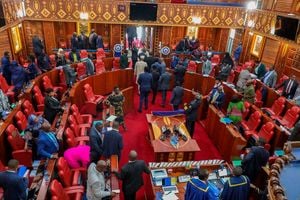
GRAPHIC | GENNEVIEVE AWINO | NMG
|Business
Premium
Kenya’s loans 60pc more expensive than Tanzania, Rwanda
Kenya’s loans from the domestic market are now 60 percent more expensive than its regional peers, including Tanzania and Rwanda, revealing the higher risk investors are attaching to lending to the government at a time it is desperate for cash.
An analysis of returns from the one-year or 364-day Treasury bill shows Kenya is now borrowing at an annualised rate of 15.61 percent compared to Tanzania’s 9.28 percent, Rwanda’s 9.7 percent and Uganda’s 12.85 percent.
Interest rates from longer-term borrowing are even higher, with the latest 6.5-year infrastructure bond auction offering investors a 17.9 percent return.
Kenya’s short-term interest rates are nevertheless below those for Ghana and Egypt where returns on the 364-day paper stand at 33.4 percent and 26.5 percent respectively at present. The higher interest rates on government securities have been grounded on a steeper benchmark interest rate by the Central Bank of Kenya (CBK), elevated inflation and missed revenue targets amidst pressure to cut expenditures.
According to analysts at Sterling Capital, many factors have combined to drive investor demands for higher interest rates at subsequent Treasury bill and bonds primary auctions.
“T-bill rates have continued on an upward trajectory. This as mentioned earlier is attributable to upward CBR revisions, high budget financing needs, relatively high inflation as well as investor expectations,” the analysts stated in a November note.
The return on the one-year/364-day T-bill is the highest in eight years since November 2015 and sets up individuals, businesses and households for even higher borrowing costs, with the government being seen as the less riskier of the four to lend to.
Churchill Ogutu from IC Asset Managers said the lack of uncertainty on the tenure and nature of securities Kenya offers had laid the building blocks for sharper borrowing costs relative to peers in the region.
“In Tanzania, the coupon rates for T-bonds are preset for primary issues, and it was just last year that they were reset lower by some 200 basis points (two percent) on average,” Mr Ogutu said. This, he said, has meant that even T-bill rates have remained depressed.
“Kenya, unlike its EAC peers, does not have a bond auction calendar, which means that there is usually a layer of uncertainty as to which bond will be on offer. Amidst a higher uncertainty, investors have jerked up T-bills to above 15 percent levels,” said Mr Ogutu.
The higher short-term interest rates have come at a cost as the government is unable to borrow through longer tenures.
Higher interest rates have forced the government to switch from its medium-term plan of issuing long-dated bonds to reduce domestic refinancing risks. The prospects for higher interest rates for longer are expected to trim the average time to maturity for government bonds.
“While the shifting of domestic debt to longer maturity is a noble debt management strategy to address refinancing risks, it must take into consideration the cost implication of long-term debt. Long-term bonds bear higher coupon rates payable for a long time,” the CBK stated in its 2022 Financial Sector Stability Report.
“Therefore, issuing a substantial amount of long-dated bonds in periods of high interest rates, shifts the entire yield curve outward, with significant implication on cost of servicing domestic debt.”
The apex bank, however, expects interest rates on government securities to fall from the re-profiling of borrowing to favour higher external financing and cooling inflation rates.
Both factors have nevertheless failed to yield results so far as rising fuel prices result in negative surprises to the consumer prices index.
Missed revenue targets in the opening quarter of the 2023/24 fiscal year have meanwhile created jitters over unrealistic revenue targets, which are usually followed by increased borrowing by the fiscal agent to cover shortfalls.
The last general spike in domestic interest rates happened in 2015 and was at the time defined largely by foreign exchange pressures which drove up volatility in the local exchange rate, resulting in jumbo interest rate increases by the CBK.
The benchmark interest rate reached a high of 11.5 percent. Interventions to rein in volatility at the time included the direct sale of forex to banks by the CBK.
Incidentally, comparable foreign exchange pressures have been prevalent this year, prompting interventions from the apex bank, including the issuance of a forex exchange code and the reinvigoration of the foreign exchange interbank market.
The CBK has similarly raised its benchmark interest rates with the view of not only dampening the demand to contain inflation but also narrowing the difference in interest rates between the country and advanced economies.
The latter have been on a tightening cycle, resulting in stronger currencies such as the dollar and the British pound.
Despite tightening monetary policy, the Kenya shilling has lost its edge against regional currencies over the past 12 months. Uganda's gained 16.4 percent against Kenya’s while the Tanzanian shilling and the Rwandese franc have gained 12.2 percent and 6.6 percent respectively.
Read more from Business Daily here.





